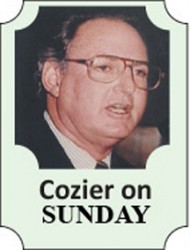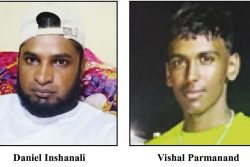By Tony Cozier
As hope continues to rapidly fade for the revival of West Indies cricket, indeed for its very future, a series 53 years ago offers a glimmer that all is not yet necessarily lost.
It was South Africa’s 1952-53 tour of Australia. The gloomy predictions that preceded them as they set out on their mission resonate with the current West Indies. The atmosphere for the “young and inexperienced team” as it set out for Australia, under captain Jack Cheetham, could “scarcely have been more gloomy,” Wisden reported. Replace Jack Cheetham with Jason Holder, Australia with Sri Lanka and the West Indies’ scenario was comparable as they went into their latest series in Galle last Wednesday, a match that ended in an innings defeat yesterday. As pessimistic as the expectations were for a team suddenly without its suspended head coach and still troubled by selection issues, their desperation wasn’t quite as acute as South Africa’s at the time.
“Many, acknowledged as sound and dispassionate judges, had suggested that the tour should be cancelled rather than allow South Africa’s cricket, admittedly at a low ebb, to suffer a sequence of seemingly inevitable crushing defeats which could cause long-standing damage,” Wisden stated.
 Indeed, after the finances for the West Indies tour the previous season had ended up in the red, the Australia board “expressed apprehension of the public reaction to a side which, by general agreement, stood in danger of being overwhelmed.”
Indeed, after the finances for the West Indies tour the previous season had ended up in the red, the Australia board “expressed apprehension of the public reaction to a side which, by general agreement, stood in danger of being overwhelmed.”
The South African board replied that it was prepared to lose as much as 10,000 pounds, then a considerable sum, on what it called “an educational tour” it hoped would put its cricket on the “right road for the future.”
Cricket Australia, as the board has come to be known, has publicly voiced no such qualms about the three West Indies Tests that come within a few weeks of those in Sri Lanka.
The Australian apprehension, loud and clear, has come from the media, perhaps echoing the opinion of some administrators.
The gist is that the successors of teams that once filled the game’s most expansive stadiums wherever they went are no longer attractive enough to merit the annual showpiece matches at the Melbourne Cricket Ground (MCG) and the Sydney Cricket Ground (SCG).
In contrast to the South African willingness to end Cheetham’s tour out of pocket, the West Indies board, under arrangements not then in place, is assured a guaranteed amount, no matter how many turn up to the MCG and the SCG.
The twist to the South African tale was incredible. Every time they appeared down and out, they came back strongly.
Defeat in the first Test was followed by victory in the second; a loss by an innings and 38 runs in the third was the kind that had originally been predicted. Unfazed, they drew the fourth and levelled the series by overcoming a first innings deficit of 85 to win the fifth by six wickets.
Wisden’s take on the turnaround serves as an example for West Indies coaches, players and administrators searching for some formula to start dragging them out of the morass of their own making.
Team Spirit
“Two reasons contributed above all towards South Africa’s success,” it wrote. “One was the standard of fielding which truly deserved the description of brilliant. The other was a fighting determination and team spirit which won the admiration of all.”
Neither was achieved by chance.
From the start, Cheetam and team manager Ken Viljoen, an earlier Test batsman, left no doubt that they would “give every fraction of their energies and thought to the task confronting them.” They expected the same from their players and got it.
It would be simplistic to expect the West Indies to emulate the South African example in every detail. There are certainly no signs they can yet match the remarkable South African story.
The constant infighting between the board and the players and the recent heated controversy over Phil Simmons’ suspension render “fighting determination and team spirit” an idealistic prospect for the West Indies. Holder, the young captain, has had a rough initiation into the toughest job in world cricket but does not seem especially daunted.
He identifies the main problem as “getting everybody together.”
“We often hear that this modern-day crop of West Indies cricketers doesn’t look that together on the field,” he has said. “That is one of my main goals, getting us to live as a family. For me, togetherness is the way forward.”
For all the dramatic changes that have overtaken the game since South Africa’s miracle in Australia, there are enough similarities between the two to make it a useful template.
It should be straightforward to emulate the South African attention to fielding as a critical aspect of the game. On arrival in Australia, Cheetham acknowledged he was not leading a team strong in batting or bowling but declared he was “resolved that we should excel in the field.”
As preparation for the Tests, they spent three or four hours a day on fielding alone. According to Wisden, spectators went to see the fielding of “these superbly fit young men as to watch them bat and bowl.”
The standard of fielding has always been a vital component in every champion team, not least the West Indies of the Seventies and Eighties which supported their formidable pace attacks with flawless catching and fleet-footed, run-saving certainty on the ground. That, too, was not by chance but by practice.
There was no evidence of such preparation in Galle where the West Indies shelled five catches, missed a key run out and, according to the television commentators, were sloppy on the ground. Sri Lanka gratefully accepted the errors to compile their 484.
Like so much else in West Indies cricket over the past two decades, the value of fielding has been largely discounted at all levels. Every other international team has a fielding coach; the West Indies haven’t had one since the well-travelled baseball specialist Julian Fountain more than 10 years ago.
The team is no longer strong in batting and bowling. With the practice that made Cheetam’s team unmatchable in the field, it might just kick start a revival, as it did for the South Africans 53 years ago.








